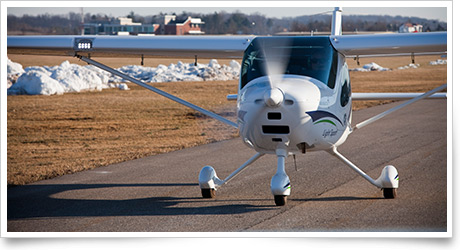| The following stories from the Jan. 18, 2012, edition of AOPA ePilot were provided to AOPA members who expressed an interest in the particular subject areas. Any AOPA member can receive information tailored to their areas of interest by updating their preferences online. |
training tipsHard runway, soft takeoff
Now, as you complete your pre-takeoff items and claim the familiar 5,000-foot-long paved runway, it becomes apparent that a notice to airmen about PSR (packed snow on the runway) was no exaggeration.
Thick blobs of plow-packed snow are scattered here and there, with many residing on the center line, beginning a few hundred feet down the runway. Those clumps are not what you'd want to encounter as your trainer accelerates to rotation speed during a normal takeoff run. Fortunately, you already have learned a technique designed to lift you safely from an uneven surface.
Making a soft-field (or rough field) takeoff is the right call today—even if you have come to associate that idea exclusively with the nearby grass strip.
Just as there, your objective is to establish a takeoff attitude (in the configuration recommended for your aircraft) that will let it rise from this obstacle course of a runway as promptly as possible. Once airborne in ground effect, be sure to level off momentarily and let your trainer accelerate to a safe, fully controllable climb speed. This may require some firm forward yoke pressure as the aircraft, which you trimmed for takeoff, gains airspeed.
The level-off and acceleration in ground effect are key to a well-executed soft-field takeoff. The airspeed indicator’s reading, confirmed by the increasingly firm feel of the flight controls, renders the cues that you have achieved a safe airspeed for continuing the climb. Remember, an aircraft can fly at a lower airspeed in ground effect than at a greater height above ground level because of the induced-drag reduction caused by ground effect. So, climbing out of ground effect too soon could cause the aircraft to settle, approach stall, or be difficult to control.
Returning to the airport from your flight, give your runway some careful inspection once again, and be sure to acquire updated notams, braking action reports, or even an observation from someone who has just landed, to learn of any surface conditions not visible from the traffic pattern. training productsSo You Want to Fly Seaplanes appYou’ve been hearing all about floatplane flying from your friends and wondering what the fuss is about. Sporty’s Pilot Shop’s new app, So You Want to Fly Seaplanes, takes you to one of the best-known havens for floatplane instruction: Jack Brown’s Seaplane Base in Florida. Fourteen video segments are used to help illustrate the maneuvers required for the FAA checkride, taxi techniques, and water takeoffs and landings. The app may be used on the iPhone, iPod Touch, and iPad. It sells for $29.99. ASA offers virtual test prep DVDASA’s Instrument Pilot Virtual Test Prep uses the latest production technology, making explanations come to life with compelling in-flight demonstrations, 3D animated graphics, instructor discussions, and talks with industry experts. The package includes a prepware test preparation software CD with all the FAA test questions, answers, and explanations for true-to-form test practice. Practice test results can then be used to receive an endorsement from ASA to take the official FAA knowledge exam.
Note: Products listed have not been evaluated by ePilot editors unless otherwise noted. AOPA assumes no responsibility for products or services listed or for claims or actions by manufacturers or vendors. final examQuestion: I’m a student pilot and want to fly solo to a neighboring airport within 25 nautical miles. I have soloed already, but only at my local airport. What do I need to do in order to solo to this neighboring field?
Answer: FAR 61.93(b)(1) states that a student pilot must receive an endorsement from an authorized instructor to make a solo flight from the airport where the student normally receives training to another location. Student pilots can make a flight within 25 nautical miles with the endorsement, provided they have received flight training from an authorized instructor at the other airport. The training must include flight in both directions over the route, entering and exiting the traffic pattern, and landings at the other airport. The instructor must endorse the student pilot’s logbook and the student must also possess the solo endorsements required of FAR 61.87. The instructor must have successfully determined the student pilot is proficient to make the flight and the purpose of the flight must be to practice takeoffs and landings at the other airport.
Got a question for our technical services staff? Email [email protected] or call the Pilot Information Center, 800/872-2672. Don’t forget the online archive of “Final Exam” questions and answers, searchable by keyword or topic. |
 You navigated the taxi course to the runway in use, giving the high snowdrifts a wide berth and exercising vigilance for other taxiing aircraft, ground vehicles, and pedestrians on the ramp, as reviewed in the Jan. 11
You navigated the taxi course to the runway in use, giving the high snowdrifts a wide berth and exercising vigilance for other taxiing aircraft, ground vehicles, and pedestrians on the ramp, as reviewed in the Jan. 11 

